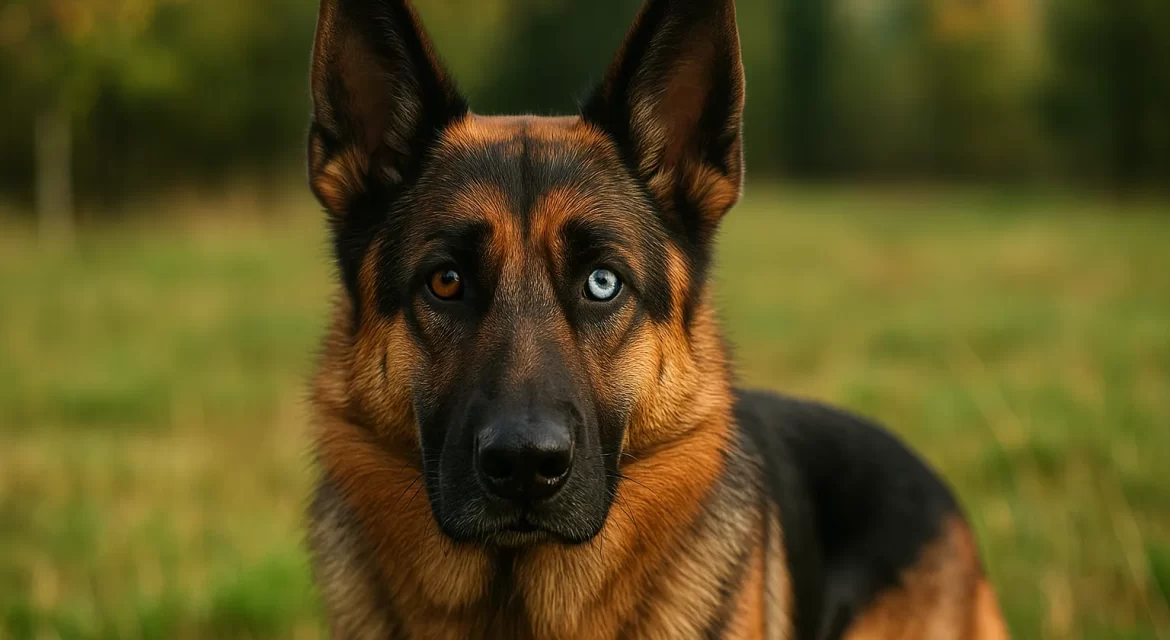Is it true that some German Shepherds can have blue or even green eyes?
Or
Ever wondered why some German Shepherds have deep brown eyes while others flash a rare icy blue?
German Shepherds aren’t just one of the most intelligent and loyal dog breeds in the world, they’re living symbols of strength, elegance, and purpose. With their powerful build, upright posture, and those sharp, alert ears, they carry themselves with a sense of confidence that commands respect. Their presence is both noble and striking, a perfect blend of grace and intensity. But beyond their athletic form and iconic silhouette lies one of their most mesmerizing and often overlooked features in their eyes.
Most people imagine the classic German Shepherd gaze deep, dark brown eyes brimming with emotion, wisdom, and intensity. But the truth is, their eyes can tell a much more colorful story. Some Shepherds have golden amber eyes that glow like fire in the sunlight, while a rare few may surprise you with piercing blue eyes that seem to see right through you.
In the most unique of cases, a German Shepherd might even have heterochromia (two different colored eyes), each one adding a touch of mystique to an already majestic dog. Let’s go through this blog and get insights into each German Shepherd’s eye color.
Different Types of Eye Color Found in German Shepherd Dog (GSD)?
1. Dark Brown Eye
German Shepherds typically have dark brown eyes, which are the most common and preferred in the breed, giving them a sharp, intelligent, and confident look. These deep, expressive eyes complement their strong and alert demeanor, contributing to the intense focus and noble presence the breed is known for. Dark brown eyes are most commonly found in traditional coat types such as black and tan, sable, and bi-color, and are seen across both working-line and show-line German Shepherds.
Why do german shepherds usually have dark brown eyes?
German Shepherds usually have brown eyes because of a pigment called melanin. Melanin is a natural substance made by the body that gives color to the eyes, skin, and coat. The more melanin in the iris, the darker the eyes appear.
The majority of purebred German Shepherds have deep brown eyes, which is the breed’s standard and preferred colour, due to their strong melanin production. Rare eye colors like German Shepherd with blue eyes or amber eyes happen when melanin levels are lower due to genetics or dilution genes, but these are not accepted in show standards.
2. Light Brown Eye
In some German Shepherds, you may notice medium to light brown eyes. While this eye color is still within the breed standard and completely normal, it is considered less ideal than the preferred dark brown, especially in conformation shows. Lighter color eyes tend to soften the dog’s overall expression, giving them a warmer, more approachable appearance compared to the intense, commanding gaze of darker eyes. This eye color is often seen in sable-coated dogs, especially those with lighter shades, and is more commonly found in liver-colored German Shepherds
3. Amber Eye
Amber eyes have a warm, golden brown tint and are less common than the usual dark brown. This rare eye color often appears in German Shepherds with specific genetic traits such as liver or liver sable coat colors. These dogs carry a recessive gene that dilutes both coat and eye pigmentation, resulting in lighter shades overall including these striking amber eyes.
Occasionally, amber tones can also be seen in blue coated German Shepherds due to similar dilution genetics. While not favored in traditional breed standards, amber eyes give the dog a unique and slightly mysterious appearance, adding a touch of wild beauty to their already captivating presence.
4. Blue Eye
Blue eye in German Shepherds is very rare and usually appears in puppies or in dogs with specific genetic traits. While they are undeniably striking and often capture attention, blue eye color is not typical for the breed and is considered outside the breed standard. In most cases, blue eyes are seen in German Shepherds that carry the dilution gene, such as blue-coated dogs.
Occasionally, blue eyes may be present in very young puppies before their eye color darkens with age, or in German Shepherd mixes like a Husky cross. Though not recognized by traditional kennel clubs, blue-eyed German Shepherds still hold a unique beauty that appeals to those drawn to rare and unusual traits.
What is Heterochromia?
Heterochromia in dog is a distinctive and eye-catching condition where each eye is a different color. It’s relatively rare, but it can occur in both animals and humans. Dogs, in particular, often turn heads when they have one blue eye and one brown or amber eye.
For a long time, people believed heterochromia might be linked to poor eyesight or illness. However, veterinary research has shown that this condition is usually harmless, especially if the dog is born with it. In those cases, it’s simply a genetic quirk and doesn’t affect vision or health.
That said, if a dog’s eye color changes later in life, it could be a sign of a medical issue. To rule out any underlying issues in such circumstances, it is essential to speak with a veterinarian.
Cause of heterochromia in German Shepherd
Heterochromia in German Shepherds is a condition where the dog has two different colored eyes, and it can occur due to several reasons. One of the primary causes is genetics, where the dog may inherit this trait from a parent, especially if there’s mixed breeding involved with breeds like Huskies or Australian Shepherds.
Another common factor is the presence of the merle or piebald gene, which can disrupt normal melanin distribution, resulting in varying eye colors. Melanin, the pigment responsible for eye color, plays a central role, less melanin in one eye leads to lighter colors like blue or amber, while more melanin produces darker shades like brown. In some cases, congenital eye conditions or irregularities during development can cause heterochromia from birth.
Also Read:
- German Shepherd Golden Retriever Mix
- German Shepherd and Poodle Mix
- German Shepherd and Rottweiler Mix
- German Shepherd and Shiba Inu Mix
What is the original eye color of a German Shepherd Dog?
The natural and commonly seen eye color of a German Shepherd is dark brown. This color is preferred in the breed standard because it gives the dog a strong, intelligent,and alert expression. While some German Shepherds may have lighter shades like amber, especially if they carry certain recessive coat color genes (such as liver or blue), these light eyes are considered less desirable in show dogs.
Very rare cases of blue eyes can occur, usually due to unusual genetics, but this is not typical of the breed. Overall, dark brown eyes are the standard and original eye color of the German Shepherd, reflecting the breed’s traditional appearance and temperament.
What is the rarest eye color of a German Shepherd?
Blue eyes are the rarest eye color in German Shepherds, which are considered a fault and typically occur due to a genetic mutation or crossbreeding a German Shepherd with blue-eyed breeds like Siberian Husky.
These eye colors are most often seen in puppies, but they can appear in adults too. While these shades are striking, they are non-standard and not accepted in breed standards.
It’s important to note that there is no proven link between non-standard eye colors (like blue) and health issues such as deafness, despite some claims. There are also rare cases of German Shepherds having green eyes, though this is typically seen in mixed-breed dogs rather than purebred ones.
What age do German Shepherds’ eyes change color?
German Shepherd puppies, like many other breeds, are usually born with blue coloration or bluish-gray eyes. This is totally natural and happens because their eyes do not contain much melanin at birth. As the grow, melanin production increases, and this causes their eye color to gradually change.
This change typically begins when the puppy is around 6 to 8 weeks old. By the time the puppy is 3 to 4 months growth stage, their eye color has usually settled into its permanent shade. For most German Shepherds, this final eye color is brown, and it can range from light amber to dark brown, depending on the dog’s genetics.
In very rare cases, a German Shepherd might keep blue eyes into adulthood, but this is uncommon in purebred dogs and may be caused by a recessive gene, a result of a genetic mutation, or crossbreeding.
Conclusion
German Shepherds’ eyes are typically brown, ranging from pale amber to deep, dark brown. Although rare eye colors like blue or hazel can occur, they are typically the result of specific genetic variations or crossbreeding and are not recognized as standard by major breed organizations.
While these unusual eye colors may be visually striking, they do not affect the dog’s abilities, personality or health in most cases.What truly makes German Shepherds remarkable is their intelligence, loyalty, and versatility as working dogs and companions. Eye color is just a small part of what makes this breed special.




